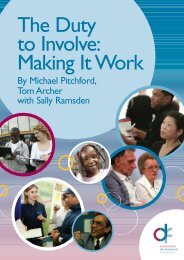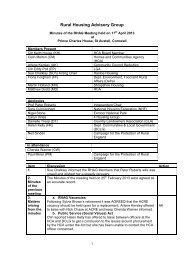Rapid Evidence Assessment of the Research ... - Rural Housing
Rapid Evidence Assessment of the Research ... - Rural Housing
Rapid Evidence Assessment of the Research ... - Rural Housing
Create successful ePaper yourself
Turn your PDF publications into a flip-book with our unique Google optimized e-Paper software.
<strong>Evidence</strong> Gaps and Fur<strong>the</strong>r <strong>Research</strong><br />
217. An econometric study would be <strong>the</strong> most sophisticated method <strong>of</strong> investigation. The determinants <strong>of</strong><br />
national and local housing demand and supply could be modelled with variables representing <strong>the</strong> impact <strong>of</strong><br />
second homes incorporated in equations that also took account <strong>of</strong> o<strong>the</strong>r influences on demand and supply. It<br />
might be possible to adapt existing models and to run <strong>the</strong>se at varying geographical scales. The data<br />
requirement for such analysis would not be unduly daunting especially if, despite <strong>the</strong> shortcomings<br />
acknowledged above, Council Tax data was accepted as <strong>the</strong> prime second homes indicator at a local level.<br />
Ideally, some verification <strong>of</strong> <strong>the</strong> data would be carried out before this econometric work commenced. However,<br />
it is not simply <strong>the</strong> contribution <strong>of</strong> second homes to <strong>the</strong> stock that needs to be investigated. It is ra<strong>the</strong>r <strong>the</strong>ir<br />
contribution to demand and supply. This means that data on <strong>the</strong> volumes <strong>of</strong> sales that are second homes is<br />
needed. This is a much more challenging requirement.<br />
218. As a precursor, or possibly a less rigorous but fast and enlightening alternative, to a detailed econometric<br />
analysis, some basic statistical relationships between affordability and second homes could be established. It<br />
would be possible to assemble data sets that showed relationships at varying geographical levels, but possibly<br />
most straightforwardly at local authority level, between changes in <strong>the</strong> volume <strong>of</strong> second homes, house prices<br />
and local income levels. This might suggest some a priori relationships between changes in property prices and<br />
affordability and changes in <strong>the</strong> volume <strong>of</strong> second homes. It would, at a minimum, be useful in assisting in<br />
specifying some clear hypo<strong>the</strong>ses about <strong>the</strong> role <strong>of</strong> second homes in local housing markets.<br />
219. Behavioural analyses involving an examination <strong>of</strong> buyers, sellers and estate agents would be useful to<br />
show <strong>the</strong> role and scale <strong>of</strong> second homes and sales activity in ways that available data does not reveal. By<br />
asking samples <strong>of</strong> players in local housing markets about <strong>the</strong> reasons for property purchase and sales, <strong>the</strong><br />
place <strong>of</strong> second homes in competing with local purchasers could be examined with some rigour. Such studies<br />
might concentrate on certain types <strong>of</strong> property with an emphasis at <strong>the</strong> lower end <strong>of</strong> <strong>the</strong> market where <strong>the</strong>re is<br />
potentially competition with first-time buyers. A sample <strong>of</strong> localities with varying proportions <strong>of</strong> second homes in<br />
<strong>the</strong> stock and <strong>the</strong> inclusion <strong>of</strong> urban as well as rural locations would make such a study particularly useful in<br />
uncovering motivations, as well as <strong>the</strong> impacts, <strong>of</strong> second homes purchasers.<br />
What specific factors attract people to buy second homes and what types <strong>of</strong><br />
property do <strong>the</strong>y buy, and where?<br />
220. In Chapter Four it was shown that <strong>the</strong>re is evidence that <strong>the</strong> two major drivers for second home<br />
ownership are a holiday/weekend/retirement home and as an investment. A fur<strong>the</strong>r significant factor is ‘working<br />
away from home’. The relative importance <strong>of</strong> <strong>the</strong>se factors in decisions to purchase second homes is, however,<br />
not known.<br />
221. It has also been argued that <strong>the</strong>re is an adequate quality <strong>of</strong> information on geographical patterns <strong>of</strong><br />
second home ownership as well as on <strong>the</strong> types <strong>of</strong> property purchased but <strong>the</strong>re is a lack <strong>of</strong> robust research<br />
on <strong>the</strong> factors influencing <strong>the</strong> behaviour <strong>of</strong> second home owners. There is some information on <strong>the</strong> key factor(s)<br />
that influenced existing second home owners, but <strong>the</strong>re is little research on potential second home owners.<br />
Also <strong>the</strong>re have been no recent detailed studies on <strong>the</strong> significance <strong>of</strong> underpinning contextual factors, such as<br />
<strong>the</strong> rural idyll and <strong>the</strong> importance <strong>of</strong> privacy and <strong>the</strong> home.<br />
222. <strong>Research</strong> on decision-making by actual and potential second home owners could usefully investigate <strong>the</strong><br />
ways that different factors combine to influence <strong>the</strong> types and locations <strong>of</strong> second home purchases. Such<br />
research could consider <strong>the</strong> search behaviour <strong>of</strong> second home purchasers and examine <strong>the</strong> varying importance<br />
<strong>of</strong> investment, ‘place to relax’ and ‘place to travel to work from’ motives in rural and urban locations.<br />
55






